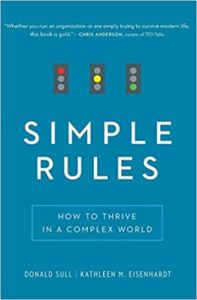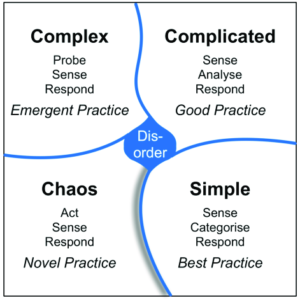Developing and Executing IT Strategies When the Crystal Ball gets Shattered

Shattered Crystal Ball
It is April of 2020 and we are in the middle of a Pandemic. The impact of this Pandemic has changed our personal and business lives in ways we could never have imagined just weeks ago. It is far from business as usual. While we know the Pandemic will pass, we don’t know when. Moreover, we don’t have a clear picture of what the economic fallout is going to be once we start getting back to a more familiar personal and business routine.
Our Crystal Ball has rolled off the table and shattered on the floor. Still, we must plan. We can’t stay in crisis mode forever. While dealing with the challenges presented today, we need to think about the post-pandemic period. Coincident to the Pandemic, I had been researching methodologies for developing strategy, and making decisions in a complex, uncertain world. I’m still in learning and research mode but thought I’d share some of my preliminary thoughts and findings.
If we are honest with ourselves, even in a normal year our strategic plans are not free from disruption. After all, we can only plan based on our personal frame-of-reference and on what we think will happen after research and interpretation of Industry Expert predictions. None of us can know what the future holds. Even with detailed strategic plans in place, we receive new information all the time that might cause them to change. What recent events have underscored for us is that we live in a world with uncertainties. It is critical to prepare to manage our planning alongside the unknowns.
Decisions, Decisions, Decisions
When it comes to making decisions, there are multiple options. Most of us are familiar with the use of decision-making tools like Multi-attribute Utility Theory, Grid Analysis, Decision Tree, and the Pugh Method. These variations of decision matrices have been used for many years. However, these tools all assume you already have a list of options defined. You simply need to decide between them.
Decision matrices are useful, but they don’t replace strategic planning. Their design is not for responding to sudden change. To get to a point where we have well-defined options and the ability to handle change, we need frameworks in place to help us plan during normal uncertainty as well as processes for dealing with disruptive new information.
There is a lot of research on this topic. I’d like to highlight two approaches I find interesting. My goal here is not to delve deeply into either of them. I’m not qualified, and this isn’t the forum. However, I want to present these ideas as a way of sparking a conversation in your Organization. Maybe the Pandemic has caused you to think about ways you could have been better prepared for that next, “I never saw that coming” event.
Simple Rules Approach
Both the approaches I’m highlighting here are in the online version of the Harvard Business Review (HBR). The first approach I’ll discuss was published in two separate issues and is referred to by the authors as the Simple-Rules approach. The first of these articles was published in the  January 2001 Issue of HBR and was titled, “Strategy as Simple Rules”. The follow-up article was published in the September 2012 Issue and was titled, “Simple Rules for a Complex World”. In these articles, Donald N. Sull and Kathleen M. Eisenhardt summarize their research and resulting approach. Subsequent to reading the articles I found the book they co-authored on this topic as well as hours of YouTube content where each of them lectures on the Simple-Rules concept.
January 2001 Issue of HBR and was titled, “Strategy as Simple Rules”. The follow-up article was published in the September 2012 Issue and was titled, “Simple Rules for a Complex World”. In these articles, Donald N. Sull and Kathleen M. Eisenhardt summarize their research and resulting approach. Subsequent to reading the articles I found the book they co-authored on this topic as well as hours of YouTube content where each of them lectures on the Simple-Rules concept.
The Simple-Rules approach is one that is used for developing strategy or defining initiatives to meet Objectives. While not specifically intended for IT, the Simple-Rules approach can be adapted for any type of Organization. One of my takeaways from the research is that the implementation of this approach is best when using a cross-functional Team. By building a team of individuals from across Divisions and Departments in your Organization, you foster coordination, improve creativity, capture concerns and priorities that might otherwise be missed, and mitigate distrust. With the Team in place, an Organization can start crafting their Simple-Rules strategy.
Identify Your Objective
At a high level, the Simple-Rules approach requires the Team to identify their Objective. The authors also refer to these as Processes. Examples could include; improve profitability by X%, increase availability of Business-Critical Applications to achieve 100% uptime, develop critical IT initiatives to be executed over the next three years. It is important the Objective(s) are as specific as possible and that they be critical to the Organization.
With the Objective identified, the Teams’ next task is to Identify bottlenecks that would keep them from being able to achieve their Objective. Bottlenecks could be lack of trained personnel, no funding, corporate red tape, etc. Once one defines the bottlenecks, the Team develops a few simple rules for how they will overcome the bottlenecks. The authors suggest there should be no more than seven (7) rules.
The idea behind the Simple-Rules approach is to reduce complexity in the decision-making process by making the Objectives and the rules for achieving them clear, concise, and few. In a world where things happen quickly and are often unexpected, having a distilled set of objectives, and rules for meeting them, will make the decision process faster.
As part of this approach, it is important to incorporate new information on a regular basis in order to make determinations about whether your objective is still relevant, your bottlenecks still exist, or your rules still apply.
Cynefin Framework
The second approach I’ve been researching was published in the November 2007 Issue of HBR and was titled, “A Leader’s Framework for Decision Making”. The article and the approach were authored by David S. Snowden and Mary E. Boone. The authors refer to this approach as the Cynefin (kuh-NEV-in) Framework. This framework is specifically designed as a decision-making tool. And, like the Simple-Rules approach, there is a book and several YouTube resources to get a better understanding for how to apply this approach.
 The basic premise of the Cynefin Framework is that every issue will fall within a certain context. It is determined by the relationship between cause and effect. Knowing the context will shape the perspective from which you make decisions about the issue. The Cynefin Framework defines the contexts within five domains that include: Obvious, Complicated, Complex, Chaotic, and Disorder. In the article, the authors define how you determine the domain that applies to your issue and, consequently, how that domain will guide your approach for resolving your issue and making decisions.
The basic premise of the Cynefin Framework is that every issue will fall within a certain context. It is determined by the relationship between cause and effect. Knowing the context will shape the perspective from which you make decisions about the issue. The Cynefin Framework defines the contexts within five domains that include: Obvious, Complicated, Complex, Chaotic, and Disorder. In the article, the authors define how you determine the domain that applies to your issue and, consequently, how that domain will guide your approach for resolving your issue and making decisions.
Organize Thinking During Times of Change
Cynefin is a tool to help organize thinking during times of change. The instinct for many of us is to act a certain way for every problem. Or worse, we panic instead of taking time to understand that the situation may require an approach we haven’t considered. At the very least, applying this approach may help you to slow down, take a breath, analyze, and keep your mind open to an ordered, thoughtful response.
Without question, we are in uncharted waters with this Pandemic. But this isn’t the first time we’ve been faced with disruptive events, nor will it be our last. Maybe you already had a reliable process in place for handling the current situation. But if you find yourself wondering if there might be a different approach for dealing with drastic change, look at the approaches described here.
I am a firm believer that preparation can be one of the biggest contributors to positive outcomes. Having a process in place for dealing with a complex, uncertain environment won’t make an organization immune to disruption. An organization that prepares could make dealing with the disruption a little easier. So, get out your broom and dustpan, sweep up the glass, and go in search of a more stable stand for your next Crystal Ball.
Categories
Search
Blog Categories
Related Resources
Archives
- July 2024
- June 2024
- May 2024
- April 2024
- March 2024
- January 2024
- October 2023
- September 2023
- August 2023
- July 2023
- June 2023
- May 2023
- April 2023
- March 2023
- February 2023
- January 2023
- October 2022
- July 2022
- June 2022
- May 2022
- April 2022
- March 2022
- February 2022
- January 2022
- December 2021
- November 2021
- October 2021
- September 2021
- August 2021
- July 2021
- June 2021
- May 2021
- April 2021
- March 2021
- February 2021
- January 2021
- December 2020
- November 2020
- October 2020
- September 2020
- August 2020
- July 2020
- June 2020
- May 2020
- April 2020
- March 2020
- February 2020
- January 2020
- December 2019
- November 2019
- October 2019
- September 2019
- August 2019
- July 2019
- June 2019
- May 2019
- April 2019
- March 2019
- February 2019
- January 2019
- December 2018
- November 2018
- October 2018
- September 2018
- August 2018
- July 2018
- June 2018
- May 2018
- April 2018
- March 2018
- February 2018
- January 2018
- December 2017
- November 2017
- October 2017
- September 2017
- August 2017
- July 2017
- June 2017
- May 2017
- April 2017
- March 2017
- February 2017
- January 2017
- December 2016
- November 2016
- October 2016
- September 2016
- August 2016
- July 2016
- June 2016
- May 2016
- March 2016
- February 2016
- January 2016
- December 2015
- October 2015
- September 2015
- August 2015
- July 2015
- June 2015
- May 2015
- April 2015
- March 2015
- February 2015
- January 2014
- February 2013




